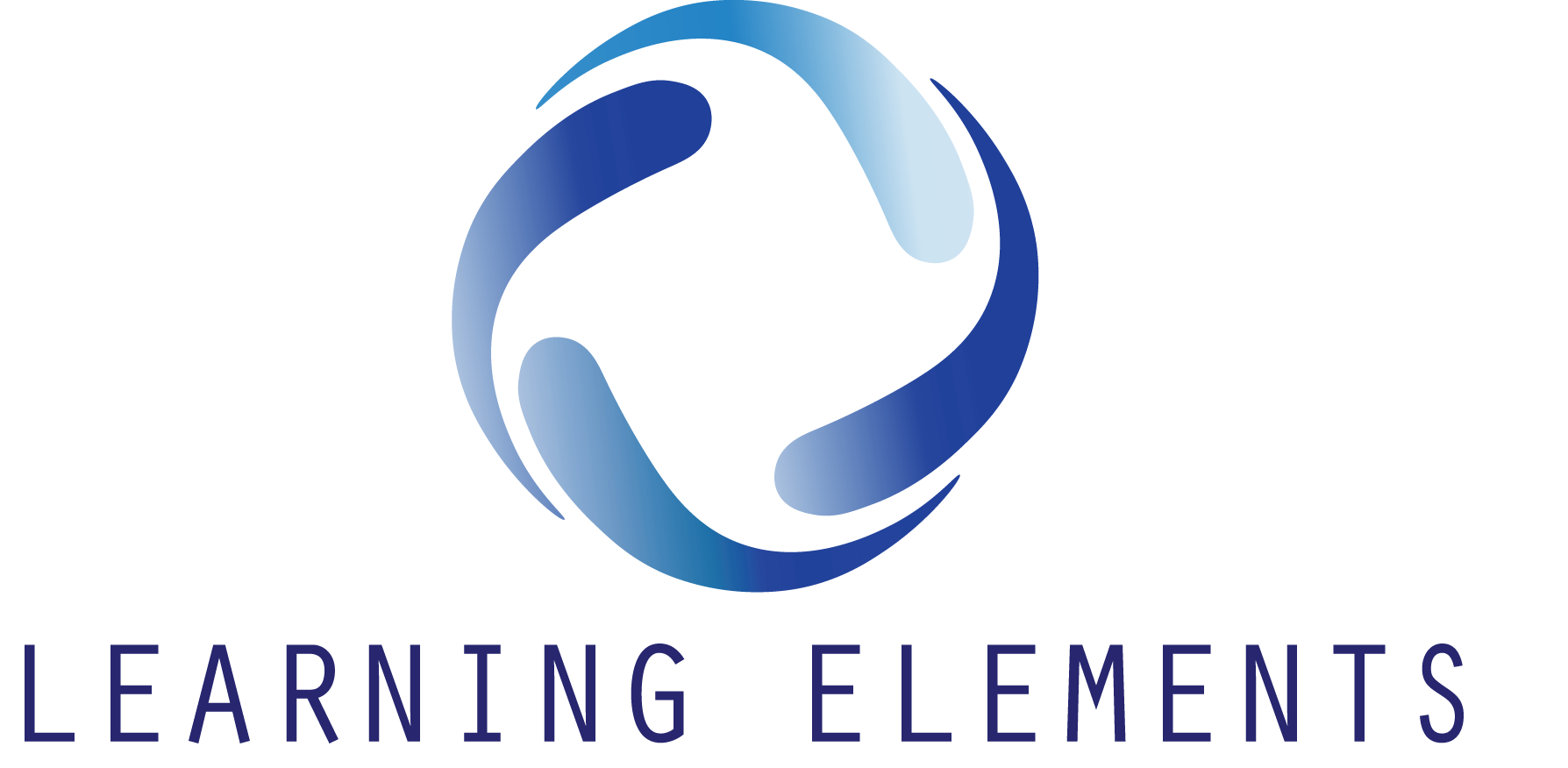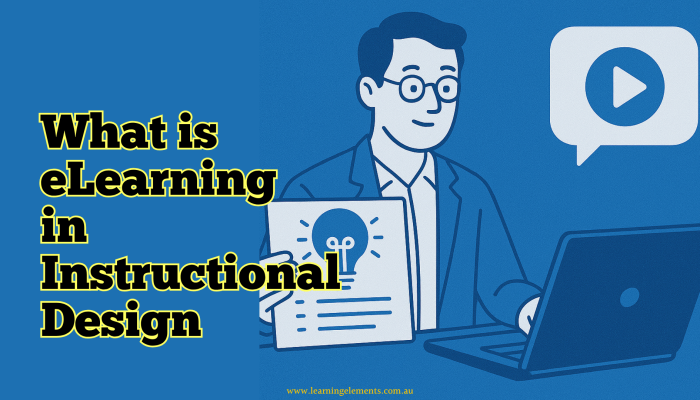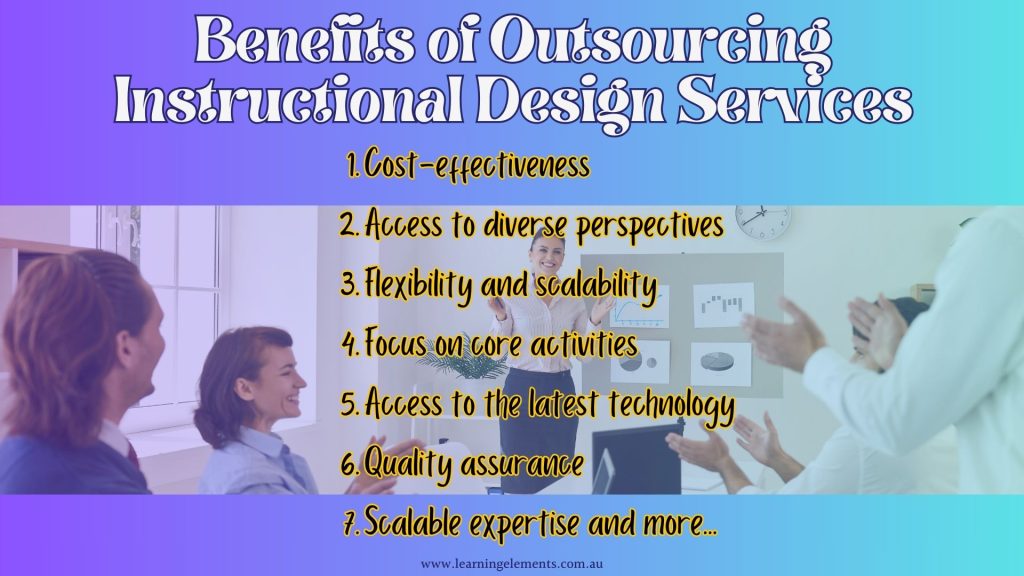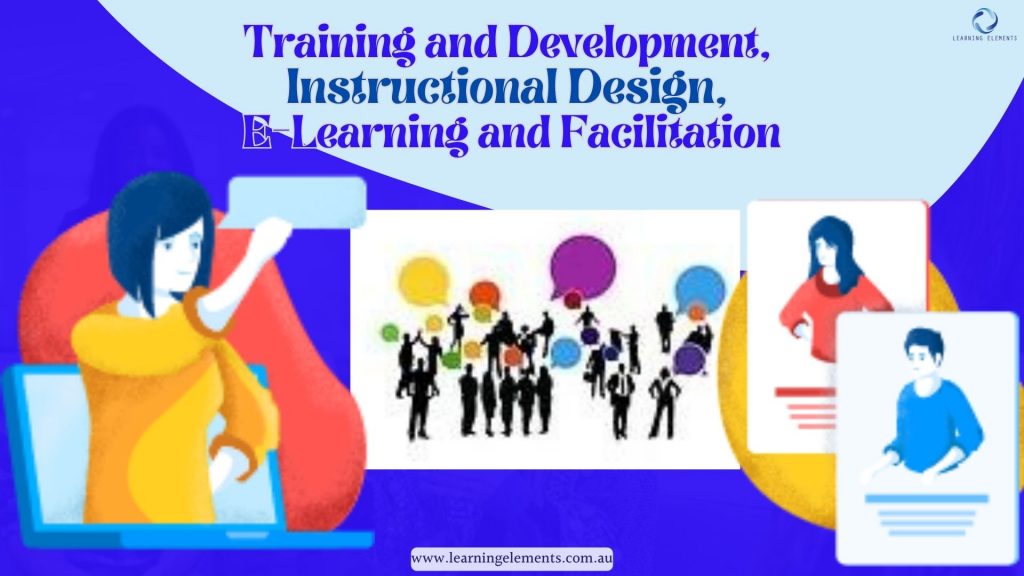What is eLearning in Instructional Design
Why understanding eLearning in the context of instructional design matters now more than ever. Online learning isn’t new, but the way it’s used has changed. What worked five or ten years ago isn’t enough anymore. Many organisations are investing in eLearning, but without proper planning, it ends up being underused or ineffective. That’s why instructional design must sit at the core of every eLearning program.
With hybrid work now the norm and team members often spread across locations, learning can’t depend on in-person sessions alone. Companies are under pressure to provide accessible, consistent training that actually leads to behaviour change. This makes well-planned eLearning a business-crucial investment—not just a nice-to-have.
Definition of eLearning in Instructional Design
To understand what eLearning in instructional design truly means, it’s important to go beyond surface-level content delivery. eLearning is more than just content on a screen. It’s a method of delivering structured learning using technology, whether through an LMS, mobile learning app, video platform, or custom digital tool. It refers to the delivery of learning experiences via digital or online platforms—not just making materials available online.
Uploading slides or PDF handouts to a portal and calling it “training” is one of the most common mistakes we see. For example, converting a PowerPoint deck into a PDF, sharing a folder full of documents, or posting a one-hour recorded Zoom session online may seem like a convenient solution, but these are not examples of effective eLearning.
Common mistakes to avoid
Many organisations mistake digitisation for transformation. Converting a 40-slide PowerPoint into a PDF and uploading it to a platform does not equal eLearning. Learners need context, interaction, and relevance. Poor design leads to low engagement, wasted time, and no real impact.
True eLearning involves interactivity, learner engagement, feedback loops, and tracking. It requires designing a purposeful, goal-oriented learning experience that helps people understand and apply knowledge. To be considered real eLearning, the experience should include:
- Clear objectives
- Interactive activities
- Opportunities for practice and feedback
- A way to measure success (e.g. quizzes, scenario-based decisions)
When well-designed, eLearning supports learning that is scalable, repeatable, and accessible—while also being more than just digital content delivery. It turns passive information into an active learning process.
What Is Instructional Design (Summary)
Instructional design is the process of analysing learning needs and systematically designing, developing, and delivering instruction. It’s about making sure that training helps people gain the right knowledge and skills, in the right way.
That means going beyond just presenting content—it’s about designing the right kind of learning experience. It starts with asking questions like:
- What should learners be able to do after the training?
- What do they already know?
- What’s the best way to bridge that gap?
The answers shape how the learning is structured—whether through videos, guided practice, scenarios, or interactive tasks. When applied to eLearning, instructional design ensures that digital training is not just convenient but also effective, engaging, and measurable.
You can read more in our previous article on Instructional Design to get a deeper understanding.
How Instructional Design Helps Create Effective eLearning
Instructional design turns eLearning from basic content delivery into a strategic and effective learning experience. It ensures that training isn’t just made available online, but that it’s purposeful, engaging, and results-driven.
Without instructional design, eLearning often becomes a content dump—slides, documents, or videos uploaded without clear goals, structure, or ways to measure learning. This results in low engagement and poor outcomes.
With instructional design, every element of the course is planned with intention. Learning objectives come first, and content, interaction, assessments, and even tone are aligned to meet those objectives. It’s not just about the tools used—it’s about how learning is designed to be useful, relevant, and applied in real contexts.
Good instructional design ensures that eLearning supports real skill-building and behaviour change. It makes digital learning experiences structured, focused, and aligned with how people actually learn—making the training not only accessible, but effective.
Want help building better online training?
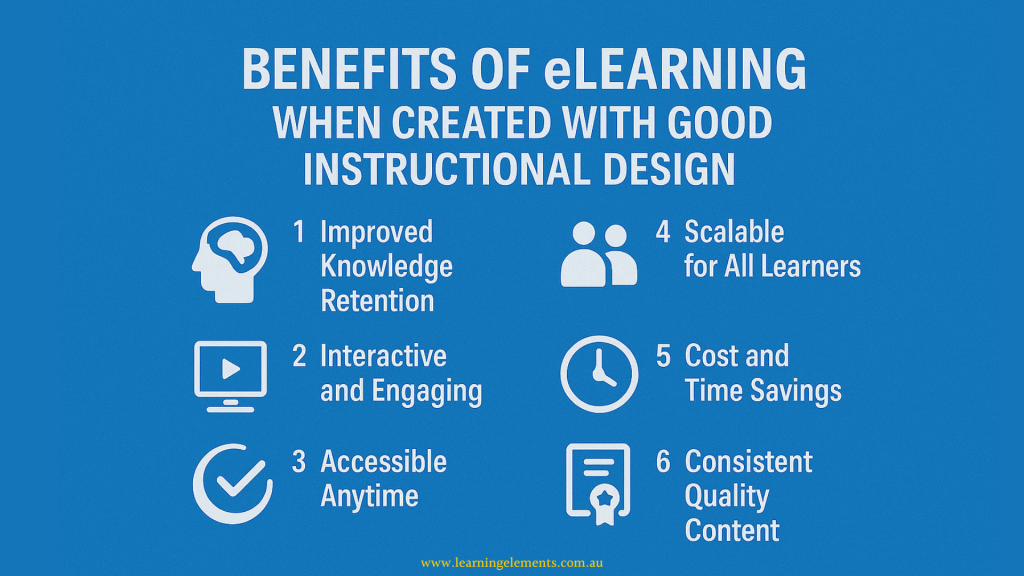
Benefits of eLearning When Created with Good Instructional Design
When eLearning is developed with proper instructional design, it delivers real value to both learners and organisations. It’s not just about making content available—it’s about creating a learning experience that’s effective, engaging, accessible, and scalable.
Here’s what strong instructional design brings to eLearning:
- Accessible anytime: Learners can access content on their own time and at their own pace. Whether they’re in an office or working remotely, they don’t have to fit into a set training slot. This flexibility supports different learning styles and schedules.
- Scalable for all learners: A well-designed course can serve a small team or scale to support thousands of learners across multiple locations. There’s no need to redesign the material every time your audience grows—making it highly efficient for enterprise-wide training.
- Interactive and engaging: Courses designed with interaction in mind—quizzes, scenarios, feedback loops—keep learners actively involved. This reduces passive consumption and improves focus and participation throughout the learning journey.
- Improved knowledge retention: When content is structured logically and reinforced through activities, learners retain more of what they learn. Instructional design strategies like repetition, chunking, and real-life examples help solidify understanding and application.
- Consistent quality content: Instructional design ensures that every learner receives the same standard of quality, regardless of where or when they access the course. This consistency is critical for maintaining brand values, compliance, and learning outcomes.
- Cost and time savings: eLearning reduces the need for physical venues, travel, printed materials, and instructor time. Well-designed digital learning programs save money and reduce time away from the job without compromising on effectiveness.
- Supports tracking and improvement: With an LMS, organisations can monitor progress, measure engagement, and identify knowledge gaps. This helps refine future training and aligns learning outcomes with organisational goals.
- Accessible across devices and environments: Well-designed eLearning works seamlessly on laptops, tablets, or smartphones, across various browsers and internet speeds. This ensures everyone—regardless of location or device—can participate equally.
In addition to these benefits, good instructional design helps reduce dropout rates. Courses that are poorly structured lose attention quickly. But when the learning path is clear, content is interactive, and feedback is built in, learners stay engaged—and are more likely to complete and apply what they’ve learned.
Ultimately, eLearning backed by strong instructional design supports not just individual development, but also long-term business success. It enables people to learn better, faster, and at scale—while maintaining quality and delivering real results.
How Learning Elements can help
At Learning Elements, we work with organisations to make their training more effective, scalable, and aligned with real business outcomes. Our approach goes beyond simply putting content online. We apply instructional design principles at every stage to ensure that the learning experience is structured, purposeful, and measurable.
Here’s how we work with clients:
1. Training needs analysis
We don’t start with content — we start with your goals. We help you identify what the learning needs really are, not just the surface symptoms. This ensures that your training solves the right problem and supports your team’s performance.
2. Effective content design
Our instructional designers create materials that reflect how adults learn in the workplace. This means using relevant scenarios, clear structure, and just enough theory to support action — not overload.
3. Custom eLearning modules
We don’t offer generic templates or one-size-fits-all courses. We design custom learning experiences that reflect your brand, tone of voice, and work culture. Modules can include video, interactive quizzes, branching scenarios, simulations, and more — all built to engage learners and reinforce learning.
4. LMS setup and support
Whether you already use a Learning Management System or are choosing one for the first time, we support you through setup, integration, and rollout. We also help you structure your LMS to align with how your people learn and how you want to track results.
5. Ongoing support and optimisation
Our work doesn’t stop once your modules are live. We track performance, gather feedback, and help you improve your learning over time — whether that means updating content, adjusting structure, or refining assessments.
FAQs
- What is eLearning in instructional design?
eLearning in instructional design refers to the creation of structured, digital learning experiences using proven instructional design methods. It ensures content is not only accessible but also effective and goal-driven. - Why is instructional design important in online training?
It ensures learning is engaging, measurable, and aligned with business goals—not just a content dump. - Can I convert PowerPoints into eLearning?
Not directly. A slide deck must be redesigned with interactivity, clear objectives, and learner feedback to qualify as effective eLearning. - How do I know if my eLearning is working?
Use tools like an LMS to track learner progress, completion rates, assessment scores, and behaviour change on the job. - What makes good instructional design for eLearning?
Clear goals, relevant scenarios, interactive activities, feedback loops, and ongoing assessment—all tailored to how people learn best.
Conclusion
In today’s fast-paced, hybrid work environment, eLearning isn’t just about accessibility—it’s about effectiveness. When instructional design is applied thoughtfully, it turns digital training into a strategic asset that drives real results. From behaviour change to business performance, good training design is what makes the difference.
Ready to improve your training outcomes with eLearning that actually works?
Talk to our team at Learning Elements—we’ll help you build smarter, more effective digital learning experiences.
